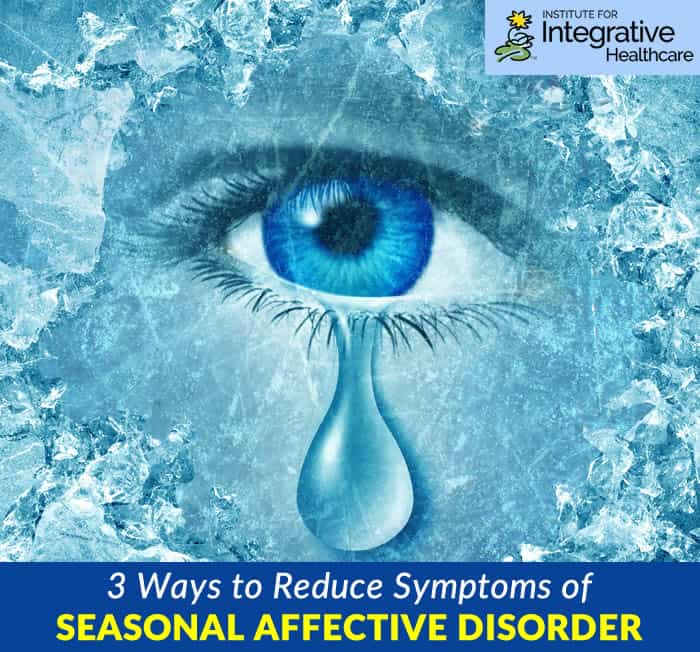

No one likes the shorter daylight hours of winter, and most of us have a tendency to stay home, eat more, curl up on the couch and engage in more sedentary activities like watching movies and surfing the Internet. It is normal to become more homebound during the cold, dark months of winter. Even when we can get outside during daytime hours, there is often a significant lack of sunlight.
For some people, the shorter winter days bring about a much more serious level of depression. Seasonal Affective Disorder, or SAD, is a form of clinical depression brought on by these shorter daylight hours during winter.
Typically symptoms of SAD begin in the fall and continue through spring, peaking November through March when sunlight hours are shortest. Decreased sunlight exposure results in decreased production of serotonin, which can negatively impact mood, appetite, sleep, memory and cognitive function, and sexual desire. Lack of sunlight also results in decreased vitamin D levels, which can negatively impact immunity, mood, sleep and digestion along with many other critical functions in the body. Especially in the north, where daylight hours are most limited during winter months, Seasonal Affective Disorder can be quite common. As many as 20 million Americans have at least a mild form of SAD, and more women than men are impacted. It is commonly found to manifest in those who have family members who also suffer from Seasonal Affective Disorder.
Symptoms and Treatments
Symptoms of Seasonal Affective Disorder include feeling sad, moody and anxious, losing interest in your usual activities, craving and eating more carbohydrates like sweets, breads and pasta, gaining weight and sleeping more. Anxiety, trouble sleeping and concentrating are also common. Other conditions can mimic SAD, including hypothyroidism, so it is important to speak with a physician to diagnose it. Typically physicians look for depression during winter months for at least two years, significant increase in appetite, especially for high-carbohydrate foods, and a marked decrease in energy and interest in life. Traditional treatments of Seasonal Affective Disorder include light therapy, antidepressants and counseling.
3 Ways to Beat Seasonal Affective Disorder
- If you find yourself suffering from the winter blues, adding regular exercise to your day may help. Getting at least 30 minutes of aerobic exercise daily and three days of weight training per week is one of the most effective ways to combat this condition.
- Also, getting outside for at least 20 minutes every day, preferably in the morning, is another great way to combat Seasonal Affective Disorder.
- Finally, massage therapy has been shown to help oppose this condition.
How Massage Can Help You Overcome Seasonal Affective Disorder
Seasonal Affective Disorder is a form of depression which can include symptoms of anxiety, sleep disturbances, general body pain and lack of energy. These symptoms make normal functioning difficult, bringing on stress. Stress and depression bring about an increase in cortisol, which further exacerbates the problems. Massage therapy has been shown to have a positive impact on most of these symptoms of depression, stress and anxiety.
Massage therapy has been shown to improve sleep quality in cancer patients, in children and in those suffering from both fibromyalgia and those with depression. Clinical trials have also proven that massage therapy can significantly reduce depression and anxiety for those suffering from a range of conditions, including Seasonal Affective Disorder. Massage therapy has been shown to reduce cortisol, to lower heart rate and improve blood pressure.
Conversely, massage has been proven to increase energy by way of increased circulation. In addition, massage therapy offers clients with SAD the benefit of human touch at a time when it is most needed. Overall, massage therapy has been proven in a variety of studies to have a positive impact on both the individual symptoms of Seasonal Affective Disorder (depression, anxiety, sleep disturbances, general pain and lethargy) and have a positive impact on clients diagnosed with SAD specifically.
Everyone suffers a bit of moodiness and mild malaise during the winter months, but when those symptoms begin to impact the quality and quantity of our activities of daily life, getting out of bed at all can become a monumental task. When sadness and lethargy begin to take over, it can be difficult to dig out of the depression that can result. Getting regular exercise, daily exposure to sunlight and massage therapy are three things that can be done to reduce symptoms of depression, improve mood and energy, and counteract this seasonal condition.











